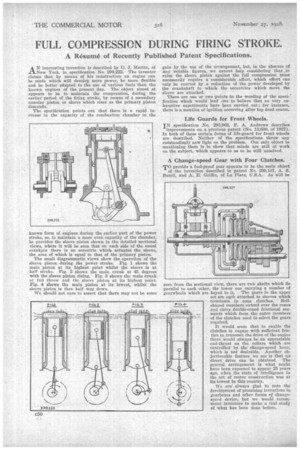FULL COMPRESSION DURING FIRING STROKE.
Page 34

If you've noticed an error in this article please click here to report it so we can fix it.
A Resumd of Recently Published Patent Specifications.
AN interesting invention is described by D. J. Martin, of New York, in specification No. 299,222. The inventor claims that by means of his construction an engine can be made which will develop more power, be more flexible and be better adapted to the use of various fuels than the known engines of the present day. The object aimed at appears to be to maintain the compression, during the earlier period of the firing stroke, by means of a secondary annular piston or sleeve which rises as the primary piston descends.
The specification points out that there is a rapid increase in the capacity of the combustion chamber in the known form of engines during the earlier part of the power stroke, so, to maintain a more even capacity of the chamber, he provides the sleeve piston shown in the detailed sectional views, where it will be seen that on each side of the ;usual crankpin there is an eccentric whic4 actuates the sleeve, the area of which is equal to that of the primary piston.
The small diagrammatic views show the operation of the sleeve piston during the power stroke. Fig. 1 shows the main piston at its highest point whilst the sleeve is at half stroke. Fig. 2 shows the main crank at 45 degrees with the sleeve piston rising. Fig. 3 shows the main crank at full throw and the sleeve piston at its highest point. Fig. 4 shows the main piston at its lowest, whilst the sleeve piston is then half way down.
We should not care to assert that there may not be some gain by the use of the arrangement, but, in the absence of any reliable figures, we cannot help considering that to raise the sleeve piston against the full compression must necessarily require a considerable effort, which effort can only be exerted by a reduction of the power developed by the crankshaft to which the eccentrics which move the sleeve are attached.
There are one or two points in the wording of the specification which would lead one to believe that no very exhaustive experiments have been carried out ; for instance, there is a mention of ignition occurring after top dead centre.
Life Guards for Front Wheels.
IN specification .No. 295,962, F. A. Andrews describes improvements on a previous patent (No. 13,630, of 1927). In both of these certain forms of life-guard for front wheels are described. Neither of the specifications throw any outstandingly new light on the problem. Our only object in mentioning them is to show that minds are still at work on the subject, which appears to us to be still unsolved.
A Change-speed Gear with Four Clutches.
TO provide a fool-proof gear appears to be the main object of the invention described in patent No. 299,107, A. S. Buten, and A. E. Griffin, of La Plata, U.S.A. As will be
seen from the sectional view, there are two shafts which lie parallel to each other, the lower one carrying a number of gearwheels which are keyed to it. The gears in the upper set are each attached to sleeves which terminate in cone clutches. Bellshaped members extend over the cones and carry double-coned frictional segments which form the outer members of the clutches used to select the gears required.
It would seem that to enable the clutches to engage with sufficient friction,te _transmit the drive of the engine there would .always be an appreciable end-thrust on the collars which are controlled by the change-speed lever, which is not desirable. Another objectionable feature we seeis that no direct drive can. be obtained. The general arrangement is what might have been expected to appear 25 years ago, when the State of intelligence in the art of -motor construction was at Its lowest in this country.
We are always glad to note the development of promising inventions in gearboxes and other forms of changespeed device, but we would recon3mend inventors to make a rent study of what has been done before.


































